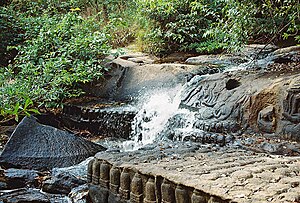Kbal Spean
| Kbal Spean | |
|---|---|

Lingas and sculptures of Hindu gods and waterfall at Kbal Spean
|
|
| Name | |
| Proper name | Kbal Spean |
| Geography | |
| Coordinates | 13°42′30.1″N 104°1′32.1″E / 13.708361°N 104.025583°ECoordinates: 13°42′30.1″N 104°1′32.1″E / 13.708361°N 104.025583°E |
| Country | Cambodia |
| Province | Siem Reap |
| District | Siem Reap |
| Locale | Angkor |
| Culture | |
| Primary deity | Shiva and Vishnu |
| Architecture | |
| Architectural styles | Bapuon architecture |
| Number of monuments | One |
| History and governance | |
| Date built | 11th to 12th centuries |
| Creator | King Suryavarman I and King Udayadityavarman II |
Kbal Spean (Khmer: ក្បាលស្ពាន) ("Bridge Head") is an Angkorian era archaeological site on the southwest slopes of the Kulen Hills to the northeast of Angkor in Siem Reap District, Siem Reap Province, Cambodia. It is situated along a 150m stretch of the Stung Kbal Spean River, 25 kilometres (16 mi) from the main Angkor group of monuments.
The site consists of a series of stone rock relief carvings in sandstone formations of the river bed and banks. It is commonly known as the "Valley of a 1000 Lingas" or "The River of a Thousand Lingas". The motifs for stone carvings are mainly myriads of lingams (phallic symbol of Hindu god Shiva), depicted as neatly arranged bumps that cover the surface of a sandstone bed rock, and lingam-yoni designs. There are also various Hindu mythological motifs, including depictions of the gods Shiva, Vishnu, Brahma, Lakshmi, Rama, and Hanuman, as well as animals (cows and frogs).
Kbal Spean is described as "a spectacularly carved riverbed, set deep in the jungle to the northeast of Angkor". The river over which the bridge head exists is also known as Stung Kbal Spean, a tributary of the Siem Reap River that rises in the Kulein mountains north of Banteay Srei. The river bed cuts through sandstone formations, and the many architectural sculptures of Hindu mythology have been carved within the sandstone. The archaeological site occurs in a stretch of the river starting from 150 metres (490 ft) upstream north of the bridge head to the falls downstream. The river, being sanctified by flowing over the religious sculptures, flows downstream, bifurcating into the Siem Reap River and Puok River, which eventually flows into the Tonlé Sap Lake after passing through the plains and the Angkor temple complex.
...
Wikipedia

